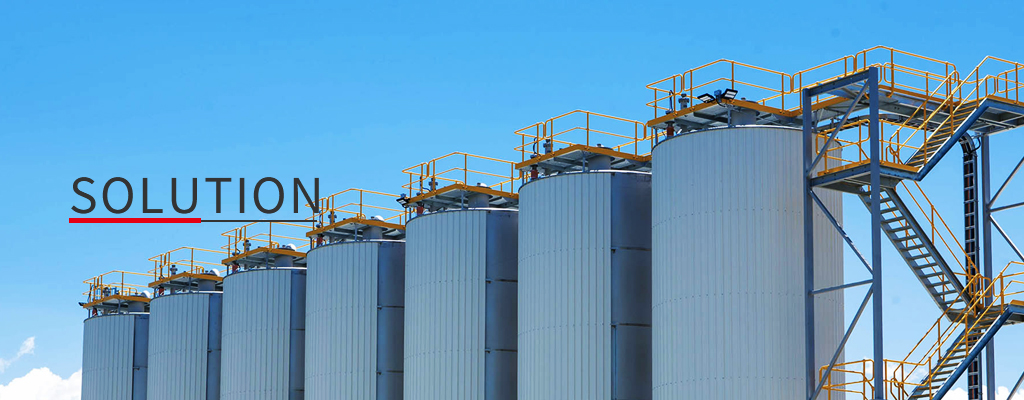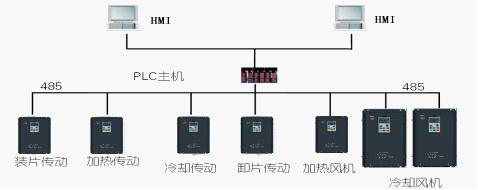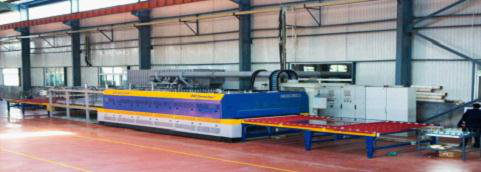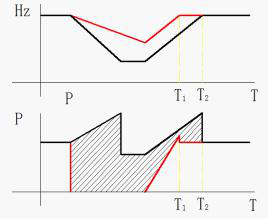

With the rapid development of science and technology, the use of tempered glass is more and more extensive, and its products are more and more abundant. In fact, tempered glass has already become the largest member of the glass deep-processing family. Tempered glass has become an indispensable important material in human life. .
I. Overview
With the rapid development of science and technology, the use of tempered glass is more and more extensive, and its products are more and more abundant. In fact, tempered glass has already become the largest member of the glass deep-processing family. Tempered glass has become an indispensable important material in human life. . Tempered glass obtains a large permanent stress through heating and quenching, so it is also called prestressed glass. If you want to eliminate this stress, you can only heat the glass again to near softening.
2. Working principle
1. The technological principle of glass tempering: the ordinary high-quality flat glass after cutting, grinding and washing is sent to the tempering furnace, and through heating (680℃~715℃) and quenching, a large permanent stress is generated in the glass— The surface is compressive stress, and the internal is tensile stress, that is, the glass produces a uniform and regularly distributed internal stress, thereby improving the strength and thermal stability of the glass.
Its production process is:
Original glass → Inspection → Cutting → Breaking → Washing → Drying → Tempering → Inspection → Packaging → Storage
The tempering process is:
Insertion → heating → quenching → slow cooling → unloading
2. Main features of tempered glass
1) High mechanical strength: When the tempered glass is subjected to external pressure such as load pressure, bending or impact, its stressed surface is subjected to compressive stress, while the other surface is subjected to tensile stress. As the load increases, this tensile stress is gradually reduced by the original compressive stress on the tempered glass surface, and it does not become a tensile stress until it is completely offset. Because the compressive strength of the glass is almost 10 times greater than the tensile strength, the glass not only strengthens the surface after tempering, but also transfers its weak links. Therefore, the compressive strength and bending strength of tempered glass are generally increased by 4 to 5 times, while the impact strength can be increased by 5 to 8 times.
2) Good thermal stability: The improvement of the thermal stability of tempered glass is just like the increase of mechanical strength, and it is also related to the size and distribution of internal stress. When the glass surface is rapidly heated, the inner layer is still in a cooling state, so that the heated surface is under compressive stress, and the inner layer is under tensile stress. When the temperature difference is too large and the tensile stress exceeds the tensile strength of the glass, the glass bursts. The original compressive stress of the tempered glass surface layer can offset some of the thermal expansion and relieve the tensile stress of the inner layer, so the thermal stability of the tempered glass can be increased by 1.5 to 2 times.
3) Strong safety: The cracking of the glass is caused by the crack defect as the starting point, which exceeds the tensile strength. Although the weak point (tensile stress zone) of tempered glass is in the center, there is usually no micro-crack defect, but under the conditions of high-speed impact and internal stones, a crack starting point will also be formed in the tensile stress layer, and the crack will be under the action of tensile stress It expands and spreads rapidly around, forming a group with many cracks and different sizes. Moreover, because the tempered glass bursts suddenly under the closed condition of compressive stress, the fragments are small honeycomb particles when broken, and they are uniform and non-sharp mesh particles, which are not easy to hurt people, so they have good safety performance and are safe A kind of glass.
3. System configuration
1. Composed of loading table, heating area, tempered cooling area, unloading area, control table and electric control cabinet. The loading table, heating area, cooling area and unloading table are driven by the cycloid pin wheel reducer to drive the chain drive. The tempered cooling area is rapidly cooled by the blower. The air duct is provided with upper and lower air grids to control the yield rate of glass tempering.
2. Electrical control system for horizontal rail tempering furnace
The electrical system of the horizontal rail tempering furnace is mainly composed of the loading table drive motor, heating zone drive motor, cooling zone drive motor, unloading table drive motor, heating and cooling fan motor, monitoring computer (HMI), PLC, inverter and various Field instrument sensor composition. The fully automatic horizontal orbital tempering furnace has manual, semi-automatic and automatic control methods. The start, stop and parameter setting of each unit of the tempering furnace are all done through HMI. At the same time, the HMI monitors the running status of the entire system. Alpha frequency converters play an important role as power drive components in the entire control system.


3. The application of Alpha frequency converter in tempering furnace mainly includes: drive and fan control
Transmission part:
Mounting drive motor 2.2KW 4 sets 5000-32R2GB
Heating drive motor 2.2KW 4 sets 5000-32R2GB
Cooling drive motor 2.2KW 4 sets 5000-32R2GB
Bending drive motor 5.5KW 2 sets 5000-35R5GB
Fan part:
Heating fan motor 250KW 1 set 6000-3250P
Cooling fan motor 315KW 2 sets 6000-3315P
Cooling fan motor 75KW 2 sets 6000-3075P
Cooling fan motor 7.5KW 13 sets 6000-37R5P
4. Control process of Alpha frequency converter in horizontal orbital tempering furnace
1) The drive inverter of the loading table transports the glass products to the heating area for heating according to the set speed
2) The drive inverter in the heating zone moves repeatedly according to the set speed, and the glass products are evenly heated
3) When the tempering temperature is reached, the cooling zone is entered, and the blast frequency conversion is used for rapid cooling
4) The drive inverter in the cooling zone moves repeatedly, and the glass products cool evenly
5) The drive inverter of the unloading table sends out the tempered glass to complete a process
6) All frequency converters are controlled by the bus, frequency setting and status reading are automatically completed
5. Matters needing attention in the commissioning process of Alpha frequency converter in horizontal orbital tempering furnace
1) The speed of each drive inverter is synchronized, and the glass products are transferred smoothly.
2) The frequency converter of the heating and cooling unit is frequently and repeatedly operated according to technological requirements,
Stop quickly and accurately according to process requirements, pay attention to the acceleration and deceleration time and speed adjustment of the inverter
3) The control of the cooling fan is critical to product quality. The cooling of the glass after heating is divided into two stages: rapid cooling and slow cooling. The basic requirement for rapid quenching of glass is rapid and uniform cooling, so that the outer layer of the glass is under pressure and the inner layer is under tension. The faster the cooling rate and the greater the temperature gradient, the greater the permanent stress, that is, the toughening stress. At this time, the process requires that the air volume and wind pressure must be established quickly in a short time, and sufficient cooling can be achieved to achieve the tempering effect. If the acceleration time of the fan is too short, the inverter can easily report overcurrent faults; if the acceleration time of the fan is slow, it is easy to cause a poor toughening effect. During the debugging process, attention must be paid to the optimization of the inverter parameters. The so-called slow cooling means that after the glass is quenched-after permanent stress is generated, the cooling intensity can be reduced to save energy consumption, and the glass can be slowly cooled to 40 ℃ ~ 50 ℃, which can be manually unloaded.
4) ALPHA inverter control plan for cooling fan
ALPHA inverter speed tracking uses hardware to accurately detect motor speed, tracking start is very stable, and tracking start current is small. The excellent speed tracking function of the ALPHA inverter can well meet the technological requirements of the cooling fan control, and the energy saving effect is better than the two-stage speed control commonly used in other products. The speed power time curve is shown in the figure below:

As shown in the figure, the red curve is the speed and energy consumption curve of Alpha from shutdown. At this time, due to the large inertia characteristics of the fan, the fan slows down very slowly. The air volume can fully meet the process requirements. At this time, the motor has no energy consumption. The start is tracked before a quench. At this time, the starting speed is high and the start time is short, which can meet the requirements of the quenching process well. In the two-stage speed control, after the quenching is completed, the inverter needs to overcome the large inertia of the fan and reduce it to the slow cooling frequency. At this time, the motor needs to consume energy. In addition, the next quick cooling needs to be accelerated from the lower slow cooling frequency to the rapid cooling frequency. In the above figure, the difference between T2 and T1 is the reduction in the processing time of the alpha inverter and other inverters, and the shaded part is the extra energy consumption of other inverters and alpha inverters.
5) The RS485 communication of the inverter adopts the modbus Rtu communication protocol to save system cost. However, the selection and erection of communication cables must follow the relevant specifications, otherwise the debugging of communication will inevitably encounter great difficulties.
Four, system advantages
1) Good heat dissipation: Alpha inverter has good heat dissipation performance
2) Compact structure: Alpha inverter is compact and can be installed side by side
3) High overload torque: Alpha inverter has higher overload torque
4) Simple communication: Alpha inverter comes with modbus communication interface
5) Powerful function: Alpha inverter comes with encoder interface, speed closed-loop control is convenient